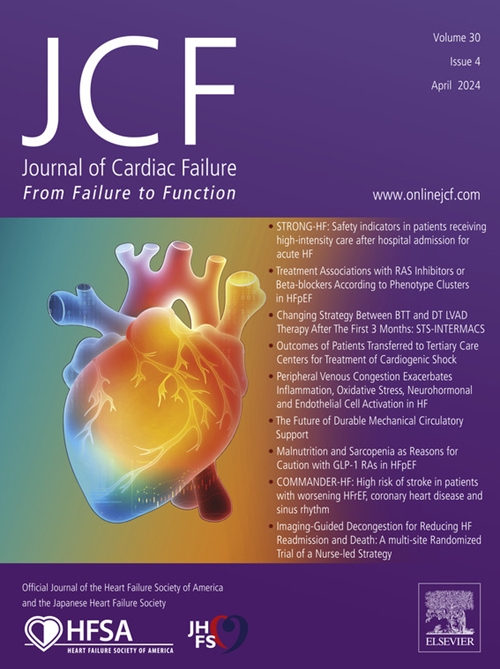Prevalence and Prognostic Implications of Changes in Tricuspid Regurgitation Severity in Acute Heart Failure
IF 6.7
2区 医学
Q1 CARDIAC & CARDIOVASCULAR SYSTEMS
引用次数: 0
Abstract
Background
Tricuspid regurgitation (TR), prevalent in acute heart failure (AHF), has a poor prognosis; however, the dynamics of TR severity during hospitalization and its prognostic implications remain unclear. We investigated TR dynamism during hospitalization and its prognostic impact in AHF.
Methods and Results
This is a post hoc analysis of a prospective multicenter study of patients with AHF who underwent echocardiographic TR severity evaluation at admission and before discharge. The primary end point was a combined of 1-year all-cause mortality and HF rehospitalization after discharge. Among 1079 participants, TR severity changed dynamically, with 60.3% of those with moderate TR and 29.6% of those with severe TR at admission being diagnosed as no or mild TR at discharge. In 3 groups stratified by changes in TR severity, the persistent TR groups had a higher incidence of the primary end point than the resolution and absence groups. In adjusted analyses, the persistent group (hazard ratio, 1.37; 95% confidence interval, 1.04–1.80), but not the resolution group (hazard ratio, 1.07; 95% confidence interval, 0.79–1.44), had a higher primary end point incidence than the absence group.
Conclusions
TR severity at admission in patients with AHF can change dynamically and is associated with subsequent prognosis. Significant TR that remains even after decongestive therapy might be a target for further treatment in hospitalized patients with AHF.
急性心力衰竭患者三尖瓣反流严重程度变化的发生率和预后意义
背景:三尖瓣反流(TR)在急性心力衰竭(AHF)中很常见,其预后较差;然而,住院期间TR严重程度的动态变化及其对预后的影响仍不清楚。我们研究了急性心力衰竭患者住院期间 TR 的动态变化及其对预后的影响:这是一项前瞻性多中心研究的事后分析,研究对象是入院时和出院前接受超声心动图 TR 严重程度评估的 AHF 患者。主要终点是出院后1年全因死亡率和心衰再住院率的总和。在1079名参与者中,TR严重程度发生了动态变化,入院时60.3%的中度TR患者和29.6%的重度TR患者在出院时被诊断为无/轻度TR。在按TR严重程度变化分层的三组中,TR持续组的主要终点发病率高于TR缓解组和TR缺失组。在调整后的分析中,持续组(危险比[HR],1.37;95% 置信区间[CI],1.04-1.80)的主要终点发生率高于缺失组,而非缓解组(HR,1.07;95% 置信区间[CI],0.79-1.44):结论:AHF 患者入院时的 TR 严重程度会发生动态变化,并与随后的预后相关。结论:AHF患者入院时的TR严重程度会发生动态变化,并与随后的预后相关。即使经过去充血治疗,仍有明显TR的AHF住院患者可能需要进一步治疗。
本文章由计算机程序翻译,如有差异,请以英文原文为准。
求助全文
约1分钟内获得全文
求助全文
来源期刊

Journal of Cardiac Failure
医学-心血管系统
CiteScore
7.80
自引率
8.30%
发文量
653
审稿时长
21 days
期刊介绍:
Journal of Cardiac Failure publishes original, peer-reviewed communications of scientific excellence and review articles on clinical research, basic human studies, animal studies, and bench research with potential clinical applications to heart failure - pathogenesis, etiology, epidemiology, pathophysiological mechanisms, assessment, prevention, and treatment.
 求助内容:
求助内容: 应助结果提醒方式:
应助结果提醒方式:


